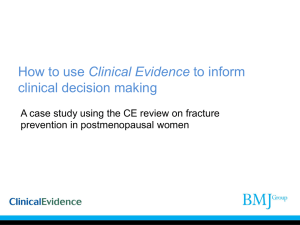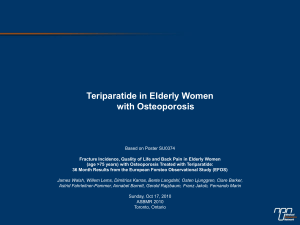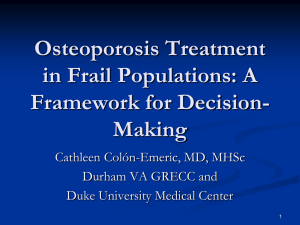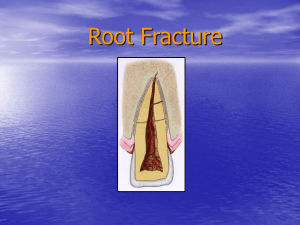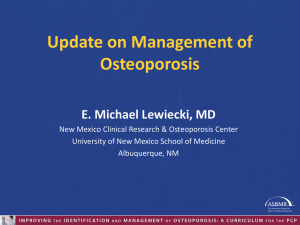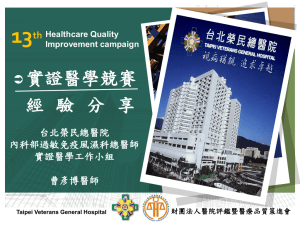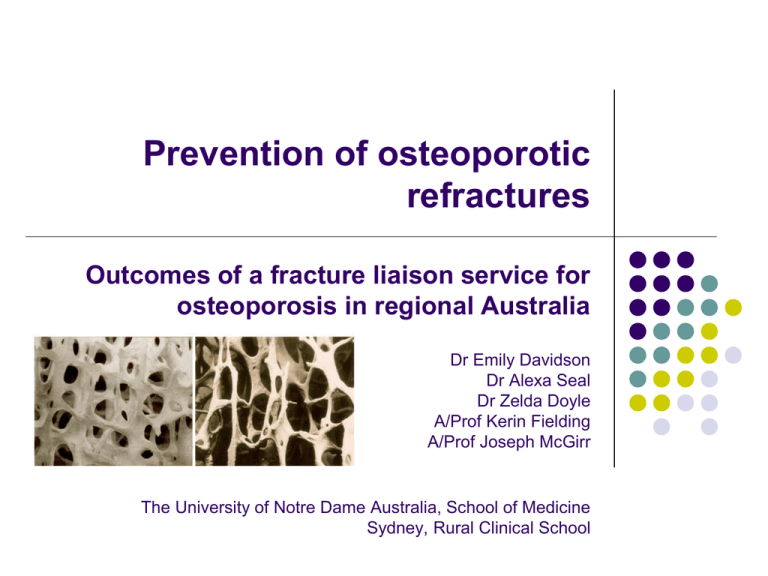
Prevention of osteoporotic
refractures
Outcomes of a fracture liaison service for
osteoporosis in regional Australia
Dr Emily Davidson
Dr Alexa Seal
Dr Zelda Doyle
A/Prof Kerin Fielding
A/Prof Joseph McGirr
The University of Notre Dame Australia, School of Medicine
Sydney, Rural Clinical School
Introduction
Impact of osteoporosis
3.3% Australian population diagnosed (1)
Mortality increases after a minimal trauma fracture (2)
Clinical Guidelines (4)
Bone mineral density scan and
Bisphosphonates or equivalent after MTF
Impact of osteoporosis
Care Gap
(5-10)
Poor adherence to guidelines
BMD rates suboptimal
Bisphosphonates low
Poor communication
Fracture Liaison Services (FLS)
Coordinated approach post MTF
Established services effective
(11,12)
Aim
To appraise the effectiveness of a pilot fracture liaison
service at improving the management of osteoporosis in
minimal trauma fracture patients in a regional NSW
health district
Methods
Method
Prospective cohort study
Eligible patients identified from hospital records
MTF presentations over an eight month period
Fractures: femur, tibia and fibula, ankle, pelvis, humerus, wrist, pathological
Age over 45yrs
Exclusion: deceased, major trauma
Recruitment
Mail and phone
Method
Intervention - Pilot fracture liaison service
Study groups
Control - MTF in the four months before pilot
Cohort - MTF in the four months after pilot
Adjusted Cohort - patients followed-up by pilot FLS
Clinical Outcomes assessed
Proportion of patients who received a BMD after MTF
Proportion newly diagnosed with osteoporosis
Proportion of patients initiated or reviewed with bisphosphonates
Results
Characteristics of eligible
and recruited patients
267 eligible patients and 88 participants recruited
54% from control period
46% from cohort period
Females accounted for majority of cases (72%)
Mean age of patients was 74 years
Femur fractures were the most common, followed by
wrist fractures
Clinical outcomes
BMD after fracture
Diagnosis of osteoporosis after fracture
36% of control versus 63% of adjusted cohort (p = 0.049)
18% of control versus 47% of adjusted cohort (p = 0.017)
Medications initiated or reviewed after fracture
Total - 20% of control and 63% of adjusted cohort (p = 0.001)
Bisphosphonates - 18% of control versus 47% adjusted
cohort (p = 0.017)
Discussion
Pilot Fracture Liaison Service
Significantly more likely
To receive a BMD scan after MTF
To be newly diagnosed with osteoporosis
To be initiated on bisphosphonates/equivalent, or have their
medications reviewed
Difference comparable to the change detected by the
Ganda et.al meta-analysis for similar FLS models
Control/baseline rates
Study detected BMD scanning rates of 38%
Northern NSW regional Base Hospital baseline rates 22% (11)
Metropolitan hospital baseline rates 20% (13)
Meta-analysis for FLS control rates between 9 - 24% (14)
Higher than expected baseline management rates
compared to similar matched studies.
Importance of using a control group when evaluating
service interventions
Limitations
Historical control
Unethical to deny patients service
Study time frame
Eight month period
? Evaluated learning curve
Pilot FLS contacted less than half of the patients within the
cohort group
? Learning curve of the service or model design
Conclusion
Conclusion
Nurse run pilot fracture liaison service can significantly
improve the management of osteoporosis in patients who have
sustained a minimal trauma fracture
Previous or future studies of FLS may over or underestimate
effectiveness if using previous documented results as control
Further evaluation of the FLS is required to assess the full
effect of this service in this region. A more intensive model of
care may be required to increase detection rates
Acknowledgements
Thank you to the staff at Wagga Wagga Base Hospital and
Medicare Local for their assistance in this research study
An additional thank you goes to Ms Varina Walsh, the
fracture liaison coordinator for this pilot study
Questions
References
1.
2.
3.
4.
5.
6.
7.
8.
Australian Bureau of Statistics (ABS). Australian Health Survey: First Results. Australian Bureau of
Statistics. 2012.
Bliuc D, Nguyen ND, Milch VE, Nguyen TV, Eisman JA, Center JR. Mortality risk associated with lowtrauma osteoporotic fracture and subsequent fracture in men and women. JAMA. 2009 Feb 4;
301(5):513-21.
Australin Institute of Health and Welfare. Health expenditure for arthritis and musculoskeletal
conditions, 2004-05. Canberra, AIHW. 2009.
The Royal Australian College of General Practitioners (RACGP). Clinical guideline for the prevention
and treatment of osteoporosis in postmenopausal women and older men.The Royal Australian College
of General Practitioners; 2010.
Teede HJ, Jayasuriya IA, Gilfillan CP. Fracture prevention strategies in patients presenting to Australian
hospitals with minimal-trauma fractures: a major treatment gap. Intern Med J. 2007 Oct; 37(10):674-9
Barrack C.M, McGirr E.E, Fuller J.D, Foster N.M, Ewald D.P. Secondary prevention of osteoporosis
post minimal trauma fracture in an Australian regional and rural population. Australian Journal of Rural
Health. 2009; 17(6):6.
Ewald DP, Eisman JA, Ewald BD, Winzenberg TM, Seibel MJ, Ebeling PR, et al. Population rates of
bone densitometry use in Australia, 2001-2005, by sex and rural versus urban location. Med J Aust.
2009 Feb 2; 190(3):126-8.
Kelly AM, Clooney M, Kerr D, Ebeling PR. When continuity of care breaks down: a systems failure in
identification of osteoporosis risk in older patients treated for minimal trauma fractures. Med J Aust.
2008 Apr 7; 188(7):389-91.
References
9.
10.
11.
12.
13.
14.
Chen JS, Hogan C, Lyubomirsky G, Sambrook PN. Management of osteoporosis in primary care in
Australia. Osteoporos Int. 2009 Mar; 20(3):491-6. Ebeling PR. Osteoporosis: it's time to 'mind the gap'.
Intern Med J. 2007 Oct; 37(10):672-3.
Gallacher SJ. Setting up an osteoporosis fracture liaison service: background and potential outcomes.
Best Pract Res Clin Rheumatol. 2005 Dec; 19(6):1081-94.
Agency for Clinical Innovation (ACI). NSW Model of Care for Osteoporosis Refracture Prevention.
Agency for Clinical Innovation: Musculoskeletal Network. Sydney, ACI. 2011.
Vaile J, Sullivan L, Bennett C, Bleasel J. First Fracture Project: addressing the osteoporosis care gap.
Intern Med J. 2007 Oct; 37(10):717-20.
Ganda K, Puech M, Chen JS, Speerin R, Bleasel J, Center JR, et al. Models of care for the secondary
prevention of osteoporotic fractures: a systematic review and meta-analysis. Osteoporos Int. 2012 Jul
25; DOI 10.1007/s00198-012-2090-y
Eisman JA, Bogoch ER, Dell R, Harrington JT, McKinney RE, Jr., McLellan A, et al. Making the first
fracture the last fracture: ASBMR task force report on secondary fracture prevention. J Bone Miner Res.
2012 Oct; 27(10):2039-46.

